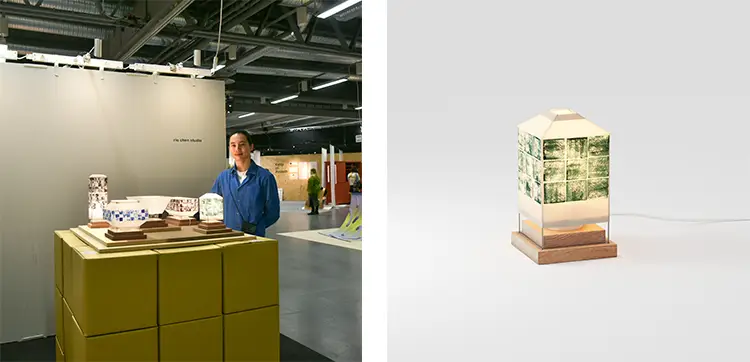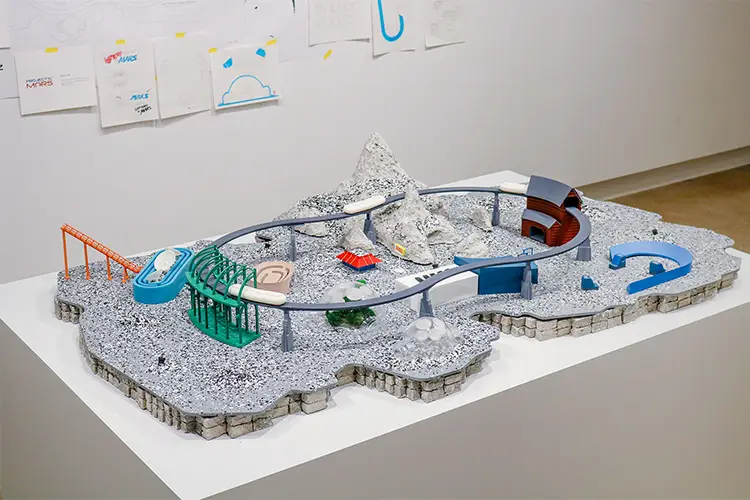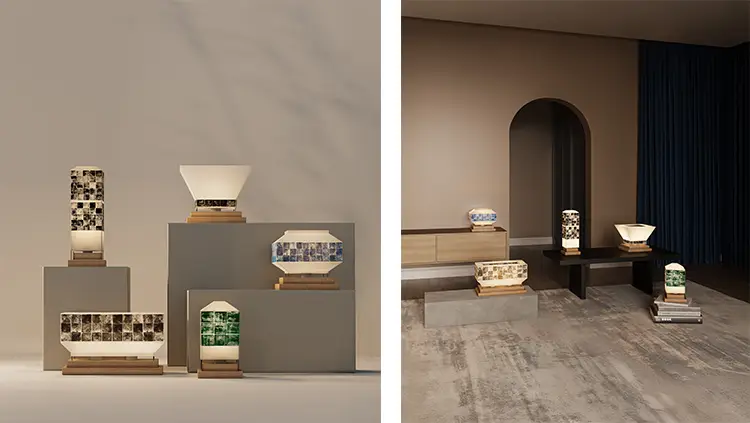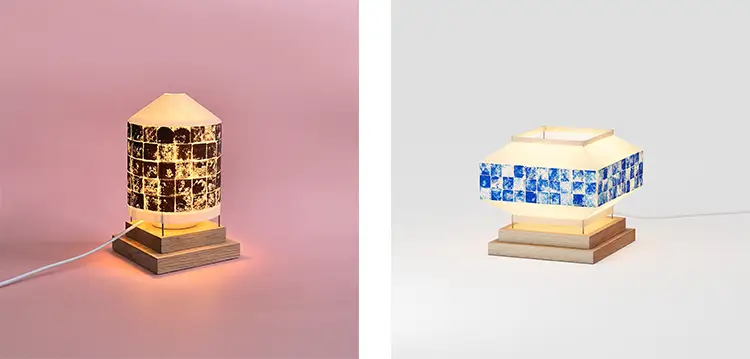“Blocks Lamps hold a special place in my heart—they are like journals of my life.”
Bringing Architecture Home
In a time when boundaries between disciplines continue to dissolve, Rio Jiunyu Chen stands as a designer whose work redefines the possibilities of domestic space. A Taiwanese artist based in Brooklyn, Chen transforms architectural principles into tactile, everyday objects, imbuing them with layers of personal meaning and spatial complexity. His artistic journey traverses continents and mediums, yet always returns to the intimate scale of the home, where design becomes both a vessel for memory and a blueprint for living. Rooted in the language of urban planning, his creations bridge the grandeur of cityscapes with the delicate intimacy of handcrafted design.
Chen’s process is profoundly informed by the methodologies of urban development—site analysis, spatial configuration, and material exploration. Rather than designing towering structures or infrastructural frameworks, he shrinks those processes down to a personal level, applying them to objects meant for the home. Each item he creates channels the logic of architecture into its form and purpose, capturing a piece of the city within a room. This convergence of scales allows his objects to tell a quiet yet compelling story: that design, no matter how small, carries the weight and wonder of the spaces we inhabit. His ability to translate macro-level planning into micro-scale beauty has become a defining feature of his practice.
What sets Chen’s work apart is the emotional charge embedded within these structural translations. His objects are not merely architectural in form but are deeply autobiographical, serving as records of time and place. They evoke a sense of movement—between countries, between disciplines, and between past and present. Through their design, they create a dialogue between memory and material, anchoring abstract experiences in tangible forms. Each creation is a monument in miniature, chronicling his evolution as an artist and a global citizen.

Rio Chen: Building a Universe, One Object at a Time
For Chen, creativity did not emerge in the expected places. It began with the roar of engines and the glint of metal. As a child enamored with automobiles, he first found joy in sketching cars, which later morphed into building cardboard prototypes of electronic gadgets. This fascination with design, engineering, and form matured over the years, eventually steering him toward the world of home object design. His career has become an evolving project—an intricate ecosystem shaped by imagination and grounded in design logic. Much like the cinematic multiverses that inspired him in his youth, Chen envisions his body of work as a connected, expanding constellation of ideas, forms, and meanings.
The heart of this evolving design universe lies in a single, unyielding question: how can ideas be communicated across materials, formats, and themes without losing coherence? This question guides Chen’s work as he shifts between mediums, scales, and conceptual frameworks. Rather than pursuing isolated projects, he views his portfolio as an interconnected dialogue, where each object builds upon the others in tone, visual language, and emotional resonance. His approach invites viewers into a holistic experience—an aesthetic ecosystem in which every new piece feels both distinct and familiar.
This design universe is not static. It grows and mutates, driven by Chen’s continual re-engagement with his personal narrative and the evolving landscapes around him. Whether shaped by the dense energy of New York, the academic rigor of Chicago, or the cultural heritage of Taiwan, his projects absorb and reflect the influences of his surroundings. By applying architectural thought to the design of objects, Chen ensures that each addition to his growing world carries both structural intent and poetic sensibility.

Designing Nostalgia: The Emotional Weight of Material Choices
Chen’s materials are chosen not merely for their tactile appeal but for the emotional echoes they carry. His preference for warm, pliable substances—wood, silicone, rubber, and soft-toned plastics—speaks to a deeper desire to evoke comfort and familiarity. These materials remind him of childhood, a period when the world felt simple, safe, and animated by imagination. By incorporating such textures and tones into his designs, he crafts objects that are more than just functional—they are emotive, suggestive of memory and mood. This choice creates an atmosphere of subtle intimacy, drawing the viewer into a space where design and sentiment coexist.
The visual language of retro popular culture also plays a central role in Chen’s work. During his graduate thesis at the School of the Art Institute of Chicago, he envisioned a floating theme park constructed from the Great Pacific Garbage Patch. Rendered in sculptural form, the project utilized black-and-white patterns and subdued hues to channel the aesthetics of bygone pop eras. The result was an imagined environment that blurred dystopia and whimsy, using cultural nostalgia to tackle ecological critique. This blend of humor, critique, and visual familiarity is emblematic of Chen’s broader approach: he uses accessible visual references to explore weighty themes in a way that invites participation rather than confrontation.
By layering nostalgic materials and visual motifs into his designs, Chen engages viewers on multiple levels—intellectually, emotionally, and sensorially. These elements act as bridges between the viewer’s own memories and the stories embedded in each object. They create a subtle emotional resonance that lingers long after the initial encounter, enriching the design with a quiet depth. In Chen’s hands, materials are not just tools of form-making; they are vessels of feeling and memory.

Rio Chen: Light, Memory, and the Expanding Blocks Universe
Among Chen’s many projects, none encapsulates his philosophy more poignantly than the Blocks Lamps. These pieces are deeply personal, each one acting as a luminous journal entry in the story of his transnational life. Moving between Taiwan, Chicago, and New York, Chen encountered a variety of urban forms, landscapes, and atmospheres—all of which found their way into the shapes and silhouettes of the lamp series. Each lamp archetype carries with it a specific memory, a fragment of skyline or shadowed alleyway, reimagined in glowing form. The use of reclaimed wood, with visible grains imprinted onto mulberry paper, adds yet another layer of temporal and geographical significance to each piece.
The Blocks Lamps do more than just illuminate a space—they encapsulate movement, transition, and lived experience. The soft, diffused glow they emit acts as a metaphor for the warmth of memory, illuminating the emotional and physical terrains of Chen’s life. Their design merges functionality with storytelling, offering users a daily reminder of the poetic potential embedded in the objects we live with. Each lamp is a quiet witness to a journey, preserving moments in a medium that is both sculptural and sensory. This interplay of light, texture, and memory defines the emotional architecture of Chen’s practice.
Chen continues to imagine new possibilities for the Blocks collection, envisioning its expansion into furniture and other forms of lighting. Originally conceived through pieces like drawers and pedestals, the “blocks” concept was always intended to be both literal and metaphorical—a foundational building unit in his design universe. As his career progresses and his experiences evolve, so too will the shapes and purposes of these objects. Yet at their core, the Blocks will remain what they have always been: enduring carriers of place, time, and personal history, built not just to be used, but to be remembered.








